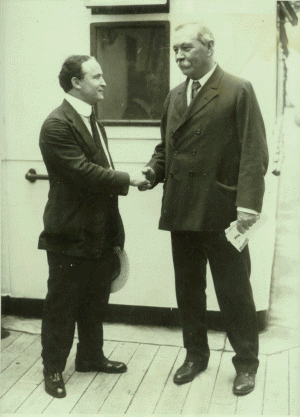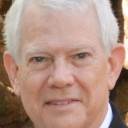March 24: Harry Houdini
Harry Houdini (1874)
It was on this date, March 24, 1874 that Harry Houdini was born Ehrich Weiss (or Erik Weisz) in Budapest, Hungary. His father, a rabbi, died shortly after the family emigrated and settled in Appleton, Wisconsin. Young Erich was devoted to his mother, but he left home as a teenager to make his fortune, found a job as a tie cutter in New York City, and performed a magic act in his spare time. He kept himself in peak physical condition and this, coupled with his dramatic good looks counterbalanced his poor education and rough English skills.
Erich adapted the name of his favorite French magician and ever afterward was known as Harry Houdini. It was in New York that he met Beatrice Rahner, a Catholic girl, and married her—three times—Catholic, Jewish and secular, just to be sure! In Europe the Houdinis first tasted success, and for the next 26 years from the turn of the century, Houdini maintained his name as a household word in vaudeville venues around the world. Houdini defied death by escaping from every container imaginable. His most famous escape, from a locked water tank while suspended upside down, was dramatized, incorrectly, as the cause of his death in the 1953 film featuring Tony Curtis. Though many believed it, the magician stoutly denied he had supernatural powers.
Houdini struck up an unlikely friendship with Sherlock Holmes creator Sir Arthur Conan Doyle. One period of this relationship was dramatized in the 1997 film, Fairy Tale: a True Story, featuring Harvey Keitel—the story of the “Cottingly Fairies,” in which Conan Doyle believed but Houdini (and history) found to be a fraud. Conan Doyle was a devout believer in Spiritualism; his wife was a medium, and Houdini’s mother had recently died. At a séance, in which Mrs. Doyle used “automatic writing” to reach the spirit world, Houdini’s orthodox Jewish mother apparently made the sign of the cross and wrote an effusive message in English, a language she never understood while alive!Yes, Houdini had the desire to believe, but the facts kept getting in his way, and he crusaded, from his mother’s death in 1913 to the end of his own life, against phony spirit mediums. As their friendship inevitably deteriorated, Houdini wrote to Conan Doyle, “I know you treat this as a religion, but personally I cannot do so, for, up to the present time, and with all my experiences, I have never seen or heard anything that could really convert me.” Conan Doyle always maintained that Houdini would not see because he would not believe: that his skepticism got in his way. Perhaps the clearest statement of Houdini’s frame of mind regarding the supernatural come from the introduction to his 1924 book, A Magician Among the Spirits—
Sir Arthur Conan Doyle, a sincere and confirmed believer in Spirit phenomena whose acquaintance I esteem, advises me that I do not secure convincing results because I am a skeptic and I therefore want to make it clear that I am not a scoffer. I firmly believe in a Supreme Being and that there is a Hereafter. … Thus it must be seen that I am not a skeptic. However, it has been my life’s work to invent and publicly present problems, the secrets of which not even the members of the magical profession have been able to discover, and the effects of which have proved as inexplicable to the scientists as any marvel of the mediums, and I claim that in so far as the revelation of trickery is concerned my years of investigation have been more productive than the same period of similar work by any scientist; that my record as a "mystifier of mystifiers" qualifies me to look below the surface of any mystery problem presented to me and that with my eyes trained by thirty years’ experience in the realms of mystery and occultism it is not strange that I view these so-called phenomena from a different angle than the ordinary layman or even the expert investigator.
Indeed, Houdini was so offended by fake spirit mediums—perhaps out of disappointment that they could never contact his beloved mother, for whom he mourned during the last 13 years of his life—that he took his crusade to Washington, DC. There, he testified before the House Judiciary Subcommittee on the District of Columbia in support of an anti-fortunetelling bill in 1926. He told the committee “In this town at $25 you are licensing blackmailing, rob[bing], and steal[ing], under the clairvoyant license. … I will show you murders and suicides, and where a medium has called a number of old men and women to finish their lives in order to join their friends.”
But the Spiritualists were organized against him and accused Houdini, a secular Jew, of crucifying Christ anew and flouting freedom of religion. “Please understand that, emphatically, I am not attacking a religion,” Houdini said. “I respect every genuine believer in spiritualism or any other religion… But this thing they call spiritualism, wherein a medium intercommunicates with the dead, is a fraud from start to finish... In thirty-five years, I have never seen one genuine medium.” Furthermore, he was accused of self-promotion because he made good money in his stage shows exposing the trickery of Spiritualist mediums. Put on the defensive, and deflected into defending his own religious beliefs, Houdini failed to get the bill passed.
As to his own religion, Houdini did keep his options open: though one of his heroes was the Great Agnostic, Robert Ingersoll, he was what could be called an open-minded skeptic—a tradition followed by another great magician greatly influenced by Houdini, and who (like Houdini) offered a large prize for a demonstration of real psychic powers, “The Amazing Randi”.
On Halloween, 1926, within a week of a freak incident coinciding with a ruptured appendix, Houdini took his last bow. Houdini gave his wife Bess a secret code to extract from any medium who presumed to contact him after he died. He did die in a Detroit hospital on 31 October 1926 in the presence of his brother Theo, at age 52. His widow conducted séances every October 31 until her own death in 1936, without successful contact, because this time Houdini was in a box from which he could not escape. Of course he could not: he designed it himself.
* [Harry] Houdini, A Magician Among the Spirits, 1924, Introduction, pp xiii-xiv.
Originally published March 2003 by Ronald Bruce Meyer.



